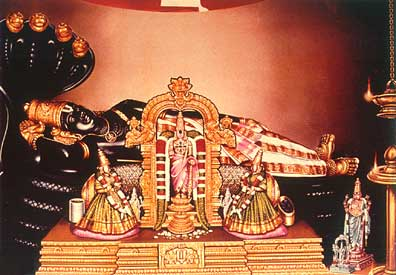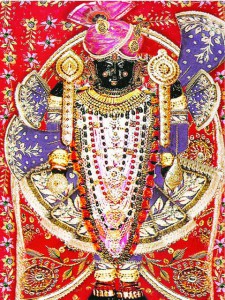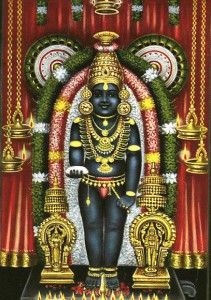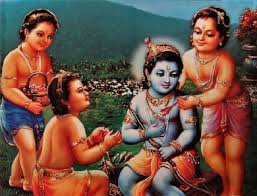Introduction to Srirangam
Srirangam is a small yet significant town located on the outskirts of Tiruchirapalli, Tamil Nadu, along the Trichy to Madras (Chennai) chord line. It is a renowned pilgrimage site, especially for Vaishnavites, drawing thousands of devotees throughout the year. The town becomes particularly vibrant during the Vaikunta Ekadashi festival, which falls in the Tamil month of Margazhi (December-January) and continues for 20 days. Despite being primarily a Vaishnavite temple, devotees from various faiths pay homage at the temple of Lord Ranganatha, the Adi Purusha Lord Vishnu in blissful slumber.
The Origin of the Ranga Vimanam
According to ancient lore, after the cosmic deluge (Pralaya), Lord Vishnu rested in the milky ocean (Kshira Sagara), from whose navel emerged a lotus flower, and from that flower, Brahma was born. Desiring to have darshan of Lord Vishnu, Brahma began a severe penance. After years of penance, Lord Narayana appeared before Brahma on Garuda and asked him what he desired. Brahma requested to see the Lord’s true form.
Lord Narayana responded that no one had seen His real Jyothi (effulgent) Swarupam and that to visualize it, Brahma would need to chant the Ashtakshara Mantra (Om Namo Narayanaya) in deep reverence. Brahma obeyed and continued his penance, which lasted a thousand years. Finally, a deity of Lord Vishnu appeared in a Ranga Vimanam from the milky ocean. The Ranga Vimanam is a special chariot-like conveyance carried by Veda Murtis, containing the Deity of Lord Vishnu inside.
In deep veneration, Brahma circumambulated the chariot four times, chanting the four Vedas with his four mouths, and then stood before Lord Vishnu in a prayerful pose. Representatives from all the worlds of the universe, including Durga, Saraswati, the Sapta Rishis, the Navagrahas, and others, attended this divine event. Brahma was overjoyed to worship the Vimanam and eventually took it to Brahma Lok.
The Journey of the Ranga Vimanam to Earth
The news of the Ranga Vimanam spread over time, and Manu, the son of Surya (the Sun God), desired to have darshan of the Ranga Vimanam. After fulfilling his desire through penance and visiting Satyaloka, Manu’s son, Ikshvaku, cherished the wish to bring the Ranga Vimanam to earth. Following the advice of his family priest, Vasishtha, Ikshvaku started a severe penance, which even puzzled the devas. They attempted to disrupt his penance but failed, leading them to pray to Brahma for help.
Brahma approached Lord Ranganatha, who expressed His desire to go to Ayodhya, where He would be worshipped by the descendants of the Solar dynasty for four yugas. After that, He would proceed to the kingdom of the Cholas in the South, on the banks of the Kaveri River. Following Ranganatha’s directive, Brahma placed the Ranga Vimanam on Garuda’s shoulders, who delivered it to Ikshvaku in Ayodhya.
Ikshvaku erected a grand temple and installed the Ranga Vimanam, where ceremonial rites and rituals continued for ages. During the Treta Yuga, Dasharatha, a descendant of Ikshvaku, ruled the country. Being childless, he performed the Putrakameshti Yaga, resulting in the birth of his four sons, including Lord Rama.
The Ranga Vimanam and Lord Rama
After Lord Rama returned from his 14-year banishment, during which he defeated the demon Ravana, his coronation ceremony was celebrated with great splendor. Vibhishana, Ravana’s brother and a great devotee of Rama, attended the ceremony along with other princes and kings. As a gesture of gratitude for Vibhishana’s assistance in defeating Ravana, Rama presented him with the highest gift—the Ranga Vimanam.
Vibhishana carried the Ranga Vimanam back to his kingdom, Lanka. However, when he reached the Kaveri River, he had to perform pooja as it was midday. He placed the Ranga Vimanam on the riverbank and performed the rituals. The Chola king Dharma Varma, who had long desired the Ranga Vimanam, requested Vibhishana to perform the Adi Brahmotsava at that very spot.
Vibhishana agreed, and the festival was celebrated with great pomp. However, when Vibhishana tried to resume his journey, he found that the Ranga Vimanam would not move. Heartbroken, he prayed to Lord Ranganatha, who revealed that He wished to stay there for some time to bless the region, including Vibhishana and Lanka. Thus, the Ranga Vimanam remained on the banks of the Kaveri, fulfilling Dharma Varma’s long-cherished desire. The Chola king constructed a magnificent structure to house the Vimanam, and after worshipping it for a long time, he attained salvation.
Lessons to be Learned
- Divine Grace and Penance: The story of the Ranga Vimanam emphasizes the power of sincere penance and devotion. Brahma, Manu, and Ikshvaku’s penances were rewarded with the darshan of Lord Vishnu, highlighting that divine grace is attainable through unwavering devotion and perseverance.
- Divine Will: The narrative also illustrates that the Lord’s will is supreme. Despite Vibhishana’s desire to take the Ranga Vimanam to Lanka, the Lord chose to stay in Srirangam, showing that divine plans may differ from human intentions, but they always serve a greater purpose.
- Unshakable Devotion: Vibhishana’s devotion to Lord Rama, even at the cost of his kingdom, serves as an example of unshakable faith. His willingness to serve the Lord over worldly possessions exemplifies the essence of true devotion.
- Divine Protection: The story demonstrates that the Lord protects and blesses those who are devoted to Him. Despite the trials faced by the devotees, the Lord’s presence ensures their ultimate salvation.
Prayer to Lord Ranganatha
O Lord Ranganatha, the eternal protector,
In Your divine slumber, You watch over the universe,
Bless us with Your grace and guide us on the path of righteousness,
May we always find refuge at Your lotus feet.
O Supreme Lord, who grants liberation,
Help us overcome the illusions of this material world,
May our devotion to You remain unwavering,
And may we attain salvation in Your divine abode.



